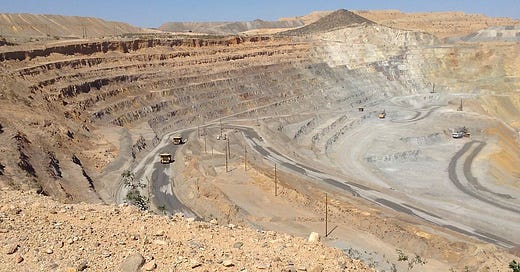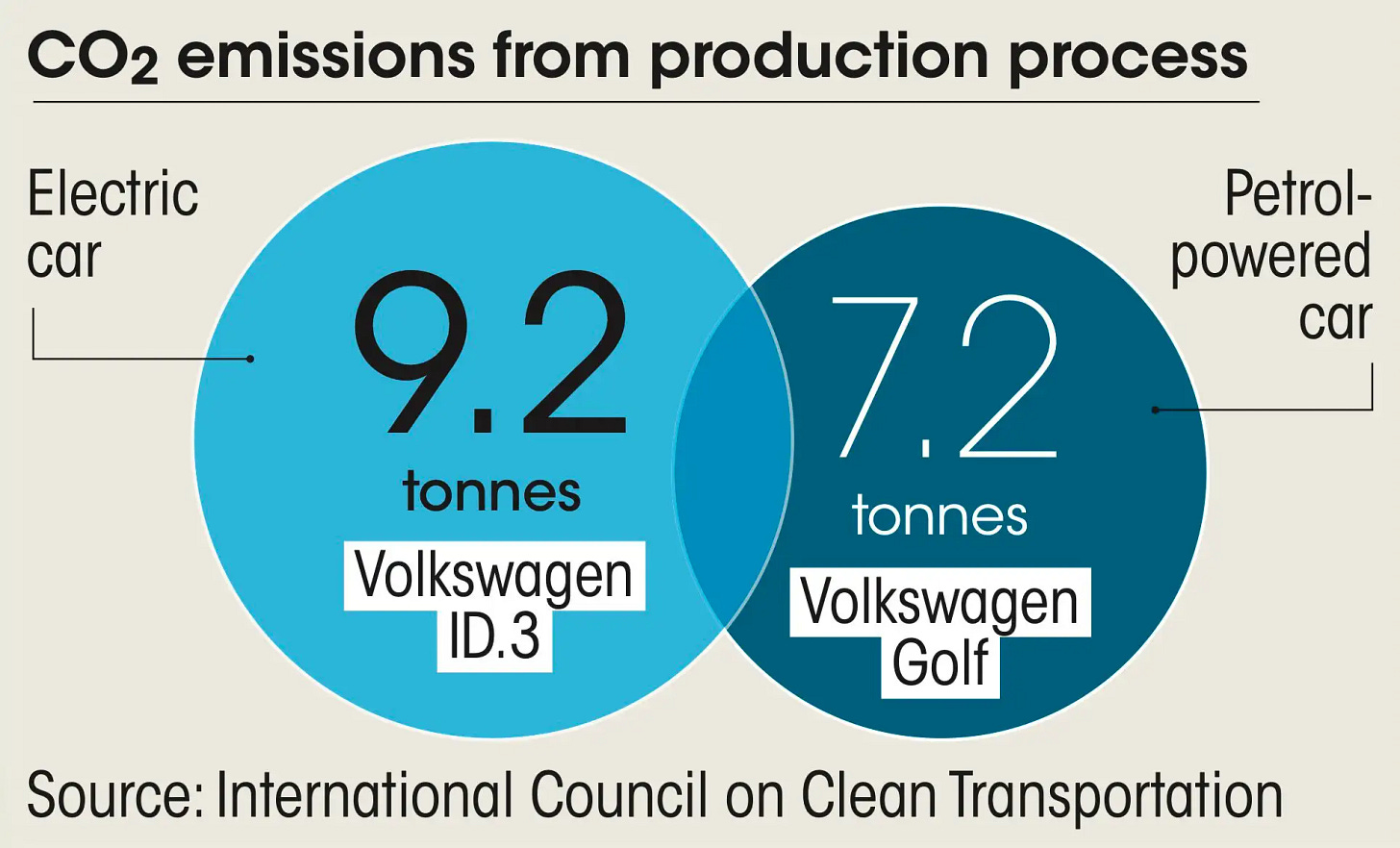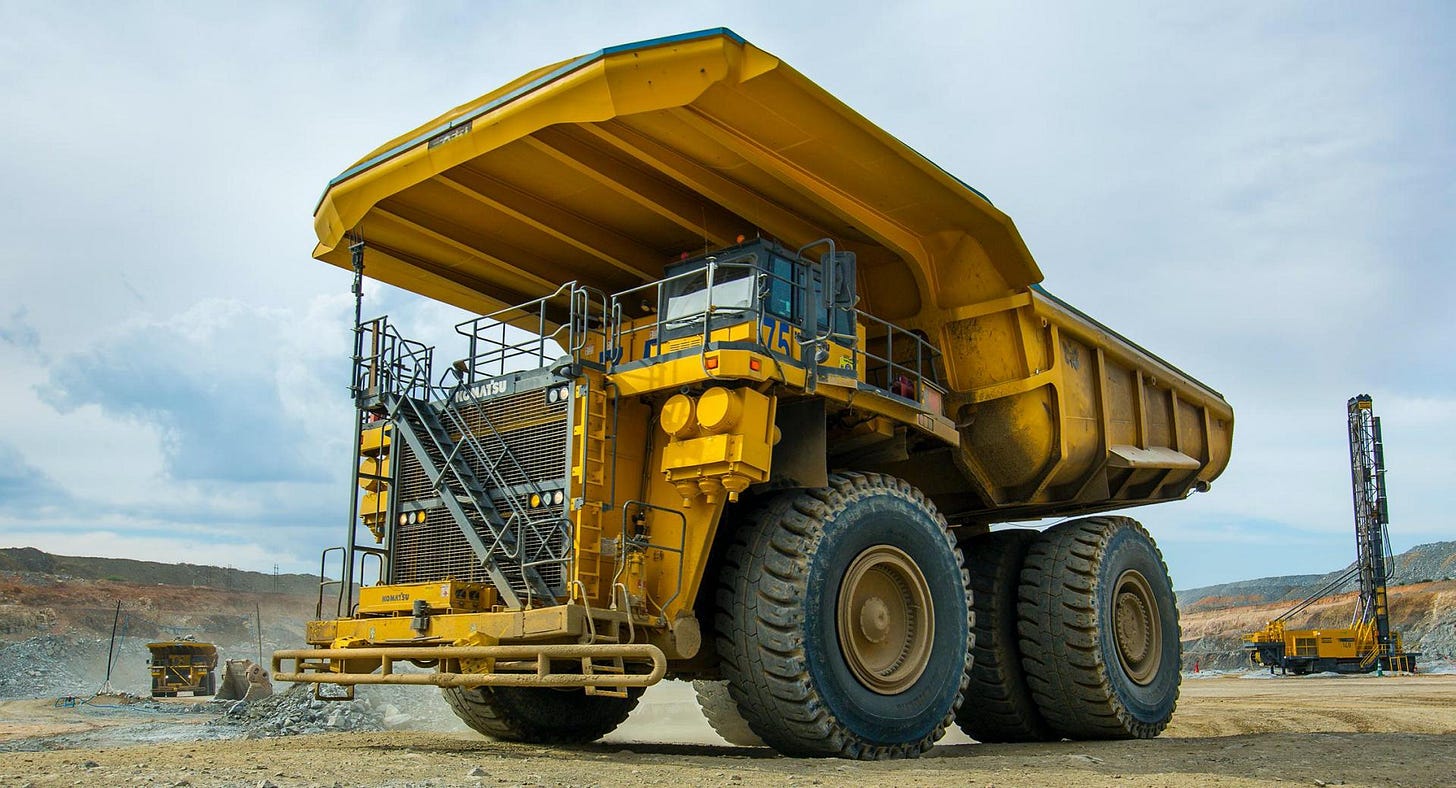Scientism and Electric Vehicles. Not much is 'green', eco-friendly, or rational about EVs.
Not a single major industrial country can power its national fleet of vehicles on EVs to say nothing of the eco-calamity that is going to transpire in pursing EVs.
(Lithium strip mine, apparently this is ‘green’.)
Abstract
‘Green’ energy is not ‘green’ but destructive of Gaia and nature. The destruction takes many forms but includes massive and devastating mining, the destruction of ecology and ecosystems, the slaughtering of fauna including birds and fowl, and the exhaustion of non-renewable minerals and materials. EV’s, wind turbines and solar panels are completely dependent upon hydrocarbons for their creation, distribution and maintenance. ‘Net zero’ standards mean nothing when you view the reality that without hydrocarbons, there won’t be any of the purported ‘green’ technologies available to use. Without hydrocarbons none of these ‘saviour-technologies’ can be built or maintained.
This medium-length post focuses on Electric Vehicle batteries and their non-green, Gaia unfriendly reality. The next two posts will analyse the Bird chopping Wind Turbines and the rather useless solar panels.
Besides the fact that there is no ‘climate crisis’, there are 3 myths that the ‘Science’ pushes about EVs or Electric Vehicles.
Myth 1: EVs ‘emit’ less ‘carbon’ than combustion engines. This is unlikely to be true (depending on what powers the grid) but in essence who cares? These calculations are probably fraudulent (Corona, Climate modelling anyone?), and don’t include the life cycle of building, transporting, replacing and disposing of EVs. Petrol and diesel cars emit trace particles of various elements as will an EV. It is however a ‘red herring’. It is a meaningless statistic.
To wit - combustion engine vehicles emit traces of carbon monoxide, nitrogen and about 17.000 pounds of Co2 over their lifetime. In total less than 8 billion tonnes of Co2 is released from petrol and diesel engines annually – a rounding error against the one trillion tonnes or more of Co2 in the atmosphere. Co2 is largely recycled so its impact is minimal. Even if EVs emit less, it is hardly going to ‘save the planet’ given there is no impact whatsoever on weather, or climate, from our collection of 10 billion or so vehicles globally.
Myth 2: EVs are Gaia friendly. This is a ridiculous assertion when you look at the extraction and strip mining used (using hydrocarbon energy), the vast seas of water needed in extraction, the pollution, chemical leeching and the lack of EV reuse and recycling. EV materials (more below) are not ‘renewable’ in that there is limited supply and mining and manufacturing these minerals relies on hydrocarbon usage.
Myth 3: EVs are cheaper. This is an absurdity. If you strip out all tax breaks, subsidies, grants and retail tax holidays and add look at real energy costs of charging, maintenance, battery replacements and insurance, EVs are probably 2x more expensive than petrol and diesel cars, fake ‘studies’ and ‘fact checks’ notwithstanding. Reality is more factual than paid-for-research by a criminal cabal.
Electric Vehicles (EV) are not ‘Green’
There is not much that is ‘Green’ about the EVs. A 60 kwH EV battery weighs between 60-80 pounds on average, which is roughly double the weight of the average petrol car battery. In an average sized EV, there exists 45 pounds of lithium and more than 10 pounds of cobalt, nickel and manganese. Copper, aluminium, and polymer plastics are other key components in an EV. None of these materials comes cheaply or at ‘net zero’ cost to Gaia.
With the exception of child slave labour which procures cobalt and other rare minerals, these components are largely processed, distributed and manufactured with hydro-carbon technology. Total reserves do not indicate the ability to mine, or the quality of the minerals. Many reserves may not be economically accessible or of high enough quality to be mined. If governments keep pushing EV usage which is now <15% of new car sales to completely replace combustion engines (called zero emissions by ‘the science’), the world will simply run out of minable minerals to feed into EV production.
About 60 pounds of batteries are needed to store the energy equivalent in one pound of fossil fuels. For every one pound of batteries produced, 50 to 100 pounds of lithium, copper, nickel, graphite, rare earths, and cobalt are mined and processed. Thus, a future of batteries for electric vehicles and back-up energy for the grid would require mining gigatons more materials as well as gigatons of materials needed to manufacture wind turbines and solar panels.
How is moving gigatons of earth, Gaia-friendly? The vast majority of the massive 200 plus tonne mining trucks excavating salt flats for lithium are hydro-carbon powered, with a few firms developing hybrids, EVs or hydrogen fuel cell engines to great and extensive mass media applause. The reality is that these huge vehicles depend on diesel for performance, duration and reliability. Renewable diesel can also be used to reduce costs and ‘emissions’ and seems to be a more practical alternative than hydrogen fuel cells, or 1000 kwh batteries which will need a reliable grid to recharge.
(Anglo American 1000 kWh battery powered mining truck, imagine the reliable grid needed to service a fleet of these monsters. Looking forward to seeing these massive batteries at the end of their useful life, dumped in a landfill leeching pollutants into the ground soil.)
For the record ‘Fossils’ don’t make fuels. Neither do rocks. Hydrocarbon energy is abiotic, self-regenerating energy made at the mantle and core. Hydrocarbons are renewable - naturally. ‘Green energy’ minerals are not renewable. How ironic.
Not Renewable
The main components and minerals needed in an EV are below, and the issues are obvious.Lithium:
The lightweight metal plays a key role in the cathodes of all types of lithium-ion batteries that power EVs.
Worldwide reserves total some 80 million tonnes. Global output is 120.000 tonnes per annum.
Australia produces 61.000 tonnes per annum, followed by Chile at 39.000.
The largest lithium reserves are found in Bolivia (21 million tonnes), Argentina (17 million tonnes), Chile (9 million), US (7 million), Australia (6 million and the largest current producer), China (5 million).
Massive amounts of earth are moved to access lithium (including salt lakes, a list of key lithium mines here). The ratio might be as high as 50 tonnes of raw earth is mined or moved, to produce 1 tonne of usable lithium.
There is anywhere from 20-200 years of lithium reserves identified based on current usage depending on your source.
However, maybe 1/3 of total reserves can be mined and it takes years to get a lithium mine operational and productive, so actual reserves are probably 30-50 years of supply at 2035 estimated demand levels.
Cobalt:
Cobalt is essential in EV batteries and a high supply risk. Costs are $70.000 per tonne or more, making it a high cost component for EVs.
Cobalt is also used in mobile phone manufacturing and other industries.
There are 7 million tonnes of cobalt reserves worldwide, with some 170.000 tonnes are mined every year.
Global Reserves: The Congo (DRC) has 50% of the world’s known supply or 3.6 million tonnes and Australia possesses some 1.6 million tonnes. Much of Congolese cobalt output is accomplished with child labour.
There might be 30-40 years of available supply which can be mined.
Manganese:
A global reserve of 800 million tonnes has been identified.
Annually about 25 million tonnes are produced and consumed, with the steel industry accounting for 80% or more of manganese consumption.
There might be 40 years supply left based on what can be mined.
South Africa produces 7.2 million tonnes per annum, Gabon some 4.6 million Australia 3.3 million tonnes, and Ukraine 400.000.
Ukraine has almost 20% of the world’s manganese reserve supply.
Graphite:
Graphite (pencil lead) is a naturally occurring form of carbon and is a critical component in various industrial applications, including the production of batteries, lubricants, and other high-tech products.
Graphite is used as an anode material in lithium-ion batteries.
Approximately 1.5 million tonnes are mined and manufactured every year, with China accounting for 850.000 tonnes. India, Brazil and Mozambique are other notable graphite producers.
Graphite is expensive to mine with an average price of $550 per metric tonne, but many projects needing almost double that price to be economical.
Graphite shortages due to increased EV demand are expected to start in 2030, substantially elevating prices which may allow some graphite mining projects to proceed.
Nickel:
A global supply of 80-100 million tonnes exist, with 3 million tonnes being mined annually.
There may be 700 million tonnes of recoverable nickel resources yet to be fully investigated and discovered (e.g. oceanic floor, New Caledonia deposits).
Australia and Indonesia have the world’s largest nickel supplies at around 21 million tonnes each.
Existing nickel supplies probably won’t be exhausted for a long while (estimates range from 100 years to 1000).
However, with increasing EV usage, nickel consumption will increase by at least 30% by 2030, putting pressure on reserves and pricing.
Copper:
Global reserves of 870 million tonnes exist with an annual usage of 28 million tonnes, there is roughly 200 years of copper reserves identified.
Chile produces about 5.5 million tonnes per year, Peru 2.5 million and China 1.5 million tonnes.
Problems with non-renewable ‘EV’ technology
(Lithium mine layout - strip mining at its finest with all the attendant ecological damage.)
There are many issues with EVs besides government coercion, massive subsidisation, rising costs and batteries catching on fire. Some key issues are listed below.
No advantages over hydrocarbons
1. Producing EVs with hydrocarbon energy and related ‘carbon emissions’, negates any ‘non carbon advantage’ from using the end product.
2. EV production uses 3 times more energy than a combustion engine.
3. EV’s must be replaced every 5-10 years at an enormous consumer cost (U$10.000 or more per EV).
4. Heavier electric vehicles will lead to road damage and increased usage of tarmac and asphalt, which are composed of carbon (tar, bitumen).
5. Insurance costs are 2-10 times higher for EVs and unaffordable for many.
6. Even with subsidies comprising some 20% of the vehicles price tag (in many countries no retail tax is applied to an EV sale, and there are direct state grants to buy one), EVs are still roughly 2x more expensive per unit than petrol or diesel vehicles.
7. EVs are far more expensive to run and maintain, regardless of mass media propaganda, especially when future electricity prices (and likely taxes) are increased to compensate for increasing demand against a limited supply.
8. EVs don’t operate well in cold climates and have limited range.
Not Gaia friendly
9. To extract one tonne of lithium requires about 500,000 litres of water, and can result in the poisoning of reservoirs and related health problems.
10. To extract 60.000 tonnes of lithium or about 6 months of supply, entails moving about 20-30 million tonnes of earth, more than the US coal industry moves in one year.
11. Less than 5% of EVs are recycled and the rest are dumped into landfills, where the various chemicals leech into the ground and groundwater. Landfill fires from disposed EVs are not uncommon.
12. By 2030 some 200 million EVs might be on the road globally leading to enormous ecological damage from the dumping of batteries as more than 250.000 tonnes of scrap waste, every year, are casually tossed into Gaia.
13. EV cars release more toxic tyre particles into the air than their petrol equivalents.
14. It is impossible to replace our large transport fleets and cargo ships with EVs. The batteries cost, weight, storage capability and the lack of infrastructure make the mass media claim that long road or oceanic haulage will be ‘electrified’ a baseless lie.
15. There is not enough national grid capacity, charging capacity or hydro-electric distribution capacity, to replace our combustion engines with EV fleets. Not now, not anytime in the future, especially if nuclear, coal and natural gas networks are declared illegal and taken offline.
The UK
According to the UK government natural gas provides almost 50% of electricity generation, nuclear 18%, and coal 1-2%. This means that irregular, extraordinarily expensive, massively subsidised wind turbines and solar panels still account for only 31% of electricity distribution. This paltry supply is all that is provisioned after trillions of £ in investments over 40 years. There are roughly 9000 wind turbines on shore and 3000 offshore in the UK. The UK will need to treble that estate to replace nuclear, coal and natural gas. This is infeasible both ecologically, and economically.
In the UK there are 70-80 million people (based on food consumption, grocery chain sales data) and more than 35 million vehicles. The UK government wants to completely ban all combustion engine usage by 2050 (part of its Net Zero target) replacing all combustion engine vehicles with EVs by 2050. What does this mean in the real world for the global minerals used in EV production?
· Twice the current annual global supply of cobalt would be needed just for the UK to have 100% EV usage in place by 2050 (replacing the current stock of combustion vehicles).
· UK demand for EV batteries will require almost the total amount of neodymium (a rare earth metal), produced globally each year, based on the ‘latest’ battery technology, which is 80 per cent nickel, 10 per cent cobalt, 10 per cent manganese.
· The UK alone will consume 75 % of the world’s lithium, and >50 % of the world’s copper to run its 35 million EVs.
Keep in mind that EV battery life is limited to less than 10 years, mandating expensive replacements and a never-ending life cycle of build-replace-build and replace. That is just one country. There is not enough supply of the minerals which are used in EVs, to replace hydrocarbon vehicle usage in the UK, let alone globally.
Nor can the UK or any other country afford Net Zero in which EVs play a vital role. By 2050, just in the UK, some £9 Trillion will be wasted to tilt at windmills to achieve ‘net zero’ whatever that phrase might mean. What would an educated, intelligent adult do with £9 Trillion over 25 years? Certainly not waste it on pointless non-green projects and the elimination of hydrocarbon usage, an energy source which is abiotic, self-producing and abundant. Many social problems can be resolved with such a largesse and investment.
The Original Sin
To misdirect the hoi-polloi the powers that be will turn to propaganda, fear and guilt. The Original Sin will now be climate ‘disruption’. The human will need to repent and reduce. The propaganda will emphasise the fear and guilt about killing Gaia, fear over the non-existing but daily refrained ‘climate crises’ caused by combustion engines and hydrocarbons, fear about the original sin of climate disruption, fear about the planet’s future if human industry and innovation are not neutered, fear and guilt about mobility and travel, fear and guilt about ‘not doing enough’. Fear and guilt are central to Net Zero and ‘de-carbonisation’ which is really just de-industrialisation. In lieu of real science, assail the emotions with religious fervour.
Evidence free EV propaganda
EVs are not ‘green’, ecologically friendly, nor can they replace our modern systems of hydrocarbon transport, nor do we have enough mineral supply to support the elimination of combustion engines with the usage of EVs nationally. Our energy grids are mostly reliant on nuclear, coal and natural gas and the intermittent, unreliable wind and solar technologies, need hydrocarbon energy sources as backups and failovers. There is no evidence that EVs are more efficient, emit less particle pollution, or consume less energy during their lifecycles. No evidence exists that EVs can replace our long-haul trucks, transports or shipping. In all cases the evidence clearly points to the opposite conclusion.
The mines used to extract lithium, cobalt and other minerals are Gaia unfriendly, moving some 50 times the amount of earth than the mined mineral along with enormous quantities of water. The impact from leeching, landfill use and contamination are likewise not eco-friendly. Cobalt mining is based on Black slave labour a fact lost on the virtue-signallers. There is no proof that EVs are eco-friendly or have a lower overall life cycle impact on Gaia. The evidence clearly points to the opposite conclusion.
In no circumstance or scenario can any sentient being, living in the real world, make a moral, economic, ecological, climatic, or ‘scientific’ case for the elimination of clean burning hydrocarbon energy, or the replacement of combustion engines with EVs. Yet that is all we see, hear and view around us – endless ‘scientific’ studies on the benefices of EVs. All of them are junk science maintaining that EV technology ‘will improve’ at some point. An article of faith, not fact.
Bottom Line
So why the rush to EVs? There is no ‘climate crisis’ except that invented by the trans-national cults of governance.
As with all Scientisms we need to follow the money. ‘Climate Change’, and its attendant cults of EVs and net-zero is a massive industry and a primary pillar of the New World Order. Money, power, control, reduced mobility for the mass, a reordering of the international system? There are many reasons why EVs and their related ‘Net Zero’ and ‘Climate’ religious dogma are being pushed.
What is rather obvious when looking at EVs and their place in the New World Order is that most people will be forced out of cars and onto public transport, bikes, scooters and skateboards. At least half the population cannot afford an electric vehicle, even if we did have enough supplies of raw materials to build EVs which we don’t. This is probably the point. A less mobile population is easier to control. Using Occam’s razor we can state that this must be a primary objective of the NWO given that EVs and net-zero certainly have nothing to do with ‘climate’ or ‘green’ technology.








